Gesouli- Voltyraki Eftihia1, Deltsidou Anna2*, Stamelaki Dimitra3, Karkageli Vasiliki4, Noula Maria5
1PhD, RN, Assistant Professor, School of Nursing Studies, Technological Educational Institution, Lamia, Greece
2PhD, RN, Assistant Professor, School of Nursing Studies, Technological Educational Institution Lamia, Greece
3Nursing Student, Technological Educational Institution, Lamia, Greece
4Nursing Student, Technological Educational Institution, Lamia, Greece
5PhD, RN, Assistant Professor, School of Nursing Studies, Technological Educational Institution, Lamia, Greece
- *Corresponding Author:
- Deltsidou Anna
PhD, MSc, RN, Assistant Professor School of Nursing Studies
Technological Educational Institution
3rd Km Old National Road of Lamia – Athens
Lamia, Greece
Tel: +0302231060210
Email: deltsidou@teilam.gr
Keywords
Breastfeeding , women attitudes , greece
Introduction
Human milk is designed specifically for human infants and is nutritionally superior to any alternative. Breast milk is considered a live tissue because it contains almost as many live cells as blood. It is bacteriologically safe and is always fresh. The nutrients in breast milk are more easily absorbed than those in formula [1].
Maternal milk is a live tissue containing many nutrients and immune substances. Breastfeeding (BF) actively protects the newborn against infections and establishes a unique bonding experience between mother and infant and increases maternal role attainment [2-5]. Although an enormous breastfeeding campaign is conducted worldwide, there is a long way ahead, in order the lactation objectives set by the world scientific community to be achieved [6,7]. Lack of information and social reasons are considered the main breastfeeding obstacles in industrialized societies. Job responsibilities as well as various prejudices enhance mother to interrupt breastfeeding or not to breastfeed at all [2,8,9]. Even further, and despite the progress in this field, many women do not quit smoking and alcohol drinking during the last semester of pregnancy and lactation [10,11]. The recording of beliefs and needs of the modern mother will allow substantial interventions towards strengthening of breastfeeding and prejudice dissolution on this matter.
Methodology
The sample size consisted of 100 women 18-45 years old from the province. Potential subjects were recruited on the basis of their availability after an informed consent was obtained. They received a brief explanation of the purpose and the aim of the study by a member of the research team and those who agreed to participate were asked to sign an informed consent form. Data collection lasted from May to July 2008. For the data collection a specific questionnaire for the purpose of the study was used. The questionnaire consisted of 12 items with subquestions, including sociodemographic characteristics, such as, age, marital status, educational level and maternity. The specific questions about breastfeeding attitudes and the intent to breastfeed, as well as, the nutritional and drinking habits during the breastfeeding period were also asked. Finally, the women were asked about the benefits of breastfeeding according to their point of view.
The questionnaire was piloted in a sample of 10 women in order to ensure that the questionnaire was understandable and easy to complete. The returned questionnaires were fully completed and the response choices were adequate and understandable.
According to the inclusion criteria the women chosen: a) were able to read and write in Greek language in order to have the ability to complete the questionnaires and b) willingness to participate in the study
Statistics
Descriptive statistics and contingency tables were used. Mann –Whitney –U test and x2 test were applied to ordinal and nominal data respectively, in order to compare subgroup values. SPSS13.0 statistical package was used.
Results
Women’s age in the sample ranged from 18 to 45 years old. The majority of women (56 %) were below 31 years old. Most women were married or divorced (56%), while 44% were unmarried. Fifty percent were mothers, 51 % were unemployed, while 58 % were of higher education. Twenty –six percent of the mothers had 2 children and 9% had three (Table 1).
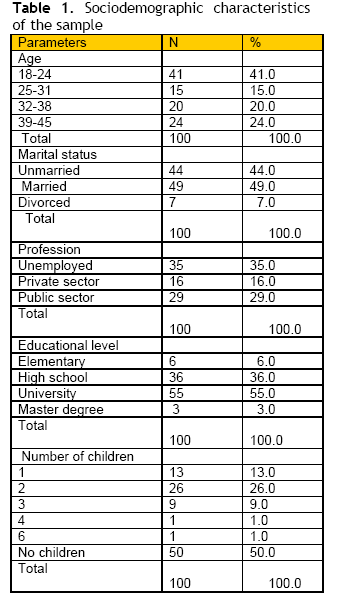
The vast majority of those who had no children reported they strongly desire to breastfeed. Eighty percent of the mothers (40 women) had breastfed their offspring. About half of them did so for over three months and 15 % from 6 to 9 months. Only one woman mentioned lack of time as an obstacle, while those women who had not breastfed their children reported insufficient milk quantity, health problems and anatomical abnormalities of the breast as the main reasons (Table 2). Even though most women have used formula feeding they do not believe that formula feeding could fully replace maternal milk (91 % prevent). As for educational level, no statistical differences were detected, even though women of lower educational class were found to breastfeed for a longer time (Table 3). It is noted that 57.5 % of women adopted a specific diet during lactation, and 25 % continued smoking (Table 4).
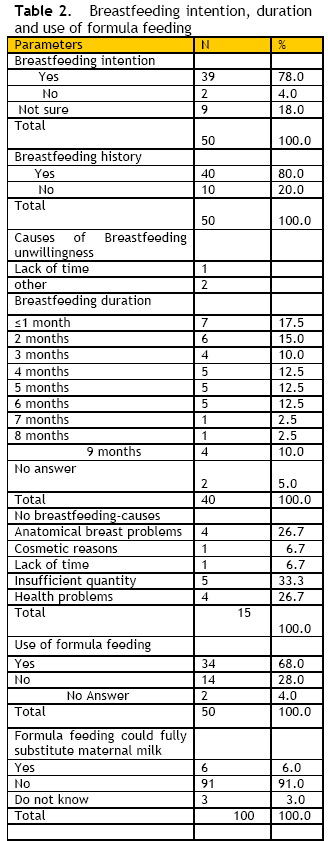
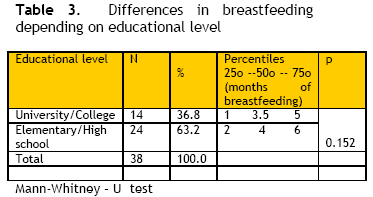
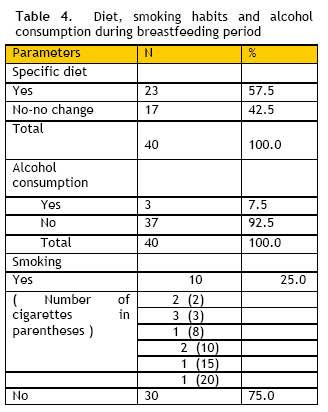
Regarding breastfeeding advantages, most of women consider that emotional bond with the child and cancer prevention are the most important on behalf of mother, while psychological development and immune system enhancement are the main advantages on behalf of the child (Table 5). There was no statistical difference in breastfeeding attitudes between employed and unemployed mothers (Table 6). The vast majority of women (81 %) considered hepatitis B carriage, breast anatomical problems and breast infections as breastfeeding contraindications (Table 7).
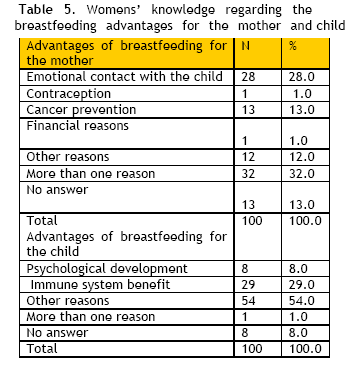
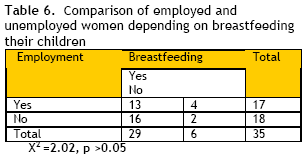
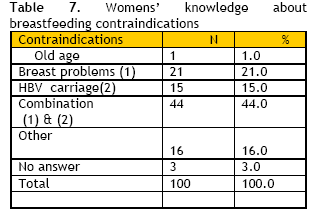
Discussion
According to our findings, the vast majority of candidate mothers desire to breastfeed. Moreover, 4 out of 5 mothers reported that they had breastfed their children, although the mean duration of breastfeeding was rather short. A small percentage had breastfed their children for 6 months. (It is noted that 4- 6 months is the recommended duration of breastfeeding, according to international guidelines) [12,13].
Unmarried mothers and less educated are less likely to breastfeed their children [6]. However, a reverse trend has been recorded in this study, although the difference was not statistically significant. Conclusions are doubtful, because of the small number of participants. More specific, less educated mothers reported a longer breastfeeding period, half to 1 month more, in comparison to married and highly educated mothers.
Nevertheless, large discrepancies are reported among different countries and monitoring systems inefficient and unreliable. The data are scarce, not only on exclusive breastfeeding but also on demographic, socio-economic, psychosocial and medical determinants of BF patterns [6,14]. Breastfeeding rates at 6 months after delivery range from 12 % to 51.3 %, while rates for exclusive breastfeeding are considerably lower [6,14-16]. Great efforts are made worldwide to increase these rates [17]. In Greece breastfeeding rates are of the lowest in the world but previous study reported rates similar (12%) to our study [18]. A discrepancy between breastfeeding desire and final breastfeeding duration is reported, which finding is consistent with previous studies.
According to their statement most women that breastfed their children adopted a healthier diet than usual. No data about specific or just an enriched diet were obtained. Few women reported alcohol drinking during lactation. No safety limits for breastfeeding mothers are established in alcohol consumption. The latter has been correlated with infant developmental disorders [19,20]. Alcohol itself rather diminishes milk quantity, despite the traditional beliefs of many cultures that encourages lactating women to drink alcohol to optimize breast milk production and infant nutrition [19,20].
As for smoking, according to the findings of the present study, one out of 4 women continues to smoke during lactation. Prevalence of maternal smoking ranges from 6 to 22 % worldwide. The highest rates in quitting smoking during pregnancy are observed in Japan [7,10,21]. A lot of progress is made towards this direction in the last years. Smoking during pregnancy and lactation is related to respiratory problems, child nervousness and infant diarrhoeas [10,21,22].
According to the findings of the present study knowledge of the great advantages of breastfeeding is well established among mothers. Emotional bonding between mother and child and normal psychokinetic development are the most frequently mentioned, as well as the prevention from maternal cancer. Various studies report that women who had breastfed their offspring are less vulnerable to breast, ovarian or endometrial cancer [23]. Hardly any disadvantages can be found in breastfeeding. Contraindications are extremely rare and the low iron concentration is the only weakness of its composition [2,3]. All other “disadvantages “are related to mother’s professional and social life. Maternal fatigue, however, should always be taken into account, in terms that most mothers work nowadays in western societies, even though a working mother can breastfeed her baby in the appropriately modified working place. Breast milk pumps are available and milk can be stored [8,24]. However, no statistical difference was observed between employed and unemployed mothers in regard to breastfeeding attitudes in this study.
Even though breastfeeding is an absolutely normal process, demanding mainly love and care, in very few circumstances is contraindicated. Most women in this survey reported that breast anatomical problems and infections (e.g mastitis, abscess, or inverted nipples) are such contraindications, as well as hepatitis B. According to recent data these problems can nowadays be successfully handled [2,4]. As for hepatitis B is considered no longer as a contraindication. However, it is necessary all the suggested precaution measures to be taken (administration of γ-globulin and newborn vaccination) and breastfeeding is interrupted if nipples hemorrhage is present. The same goes for hepatitis C, while HIV transmission is possible, so HIV infected mothers are advised not to breastfeed [27,28,29].
Maternal milk is the richest food in substances of high biological value (proteins, vitamins, minerals, fat and sugar). These nutrients are administered in balance with the infant’s demands breast milk contains antibodies, which protects the newborn against infections and other diseases (e.g cancer) as well. On the other hand, breastfeeding is important for the psychokinetic development of the newborn. Attachment to breast strengthens the bond between mother and child and contributes to psychological health of both mother and child [2,3,25,26].
The findings of the present study showed that women are familiar with breastfeeding benefits. Nevertheless, lack of information and social reasons often discourage breastfeeding. More information is necessary directed to the future mothers regarding breastfeeding contraindications although the latter are extremely rare. Health professionals should keep abreast of the novel evidence in breastfeeding and care about the promotion of this natural and beneficial, process.
3643
References
- Lowdermilk DL, Perry SE. Maternity Nursing, 6th Ed, Mosby, Philadelphia, 2003
- Patsourou A. Breastfeeding. A wonderful Bonding .Modern Horizons, 2007
- Lawrence RA, Howard CR. Given the benefits of breastfeeding, are there any contraindications? Clin Perinatol. 1999; 26(2):479-90
- Gartner LM, Black L, Eaton A. Breastfeeding and the use of human milk Pediatrics 1997;100:1035-1039.
- Yngve A, Sjöström M. Breastfeeding in countries of the European Union and EFTA: current and proposed recommendations, rationale, prevalence, duration and trends. Public Health Nutr. 2001;4(2B):631-45
- Suellentrop K, Morrow B, Williams L, D'Angelo D; Centers for Disease Control and Prevention (CDC). Monitoring progress toward achieving Maternal and Infant Healthy People 2010 objectives--19 states, Pregnancy Risk Assessment Monitoring System (PRAMS), 2000-2003. MMWR Surveill Summ. 2006;55(9):1-11
- Meek JY Breastfeeding in the workplace. Pediatr Clin North Am. 2001; 48(2):461-74
- Zinn B. Supporting the employed breastfeeding mother. J Midwifery Womens Health. 2000;45(3):216-26
- Kaneko A, Kaneita Y, Yokoyama E, Miyake T, Harano S, Suzuki K, Ibuka E, Tamaki T, Nakajima H, Ohida T.Smoking trends before, during, and after pregnancy among women and their spouses. Pediatr Int. 2008; 50(3):367-75.
- Little RE, Anderson KW, Ervin CH, Worthington-Roberts B, Clarren SK. Maternal alcohol use during breast-feeding and infant mental and motor development at one year. N Engl J Med. 1989; 17;321(7):425-30
- Breastfeeding 2001, Part I, The Evidence for Breastfeeding Pediatr Clin North Am 2001; Volume 48(1).
- Fewtrell MS, Morgan JB, Duggan C, Gunnlaugsson G, Hibberd PL, Lucas A, Kleinman RE. Optimal duration of exclusive breastfeeding: what is the evidence to support current recommendations? Am J Clin Nutr. 2007; 85(2):635S-638S
- Beck LF, Morrow B, Lipscomb LE, Johnson CH, Gaffield ME, Rogers M, Gilbert BC. Prevalence of selected maternal behaviors and experiences, Pregnancy Risk Assessment Monitoring System (PRAMS), 1999. MMWR Surveill Summ. 2002; 51(2):1-27
- Novotny R, Hla MM, Kieffer EC, Park CB, Mor J, Thiele M.Breastfeeding duration in a multiethnic population in Hawaii. Birth. 2000; 27(2):91-6
- Win NN, Binns CW, Zhao Y, Scott JA, Oddy WH.Breastfeeding duration in mothers who express breast milk: a cohort study. Int Breastfeed J. 2006 ; 1:28.
- Walker M. International breastfeeding initiatives and their relevance to the current state of breastfeeding in the United States. J Midwifery Womens Health 2007; 52(6):549-55
- Theofilogiannakou M, Skouroliakou M, Gounaris A, Panagiotakos D, Markantonis SL. Breast-feeding in Athens, Greece: factors associated with its initiation and duration. J Pediatr Gastroenterol Nutr 2006;43(3):379-84
- Mennella J. Alcohol's effect on lactation. Alcohol Res Health. 2001;25(3):230-4.
- Little RE, Northstone K, Golding J; ALSPAC Study Team. Alcohol, breastfeeding, and development at 18 months. Pediatrics 2002;109(5):E72-2
- Maritz GS. Nicotine and lung development.Birth Defects Res C Embryo Today 2008;84(1):45-53
- Amir LH, Donath SM. Does maternal smoking have a negative physiological effect on breastfeeding? The epidemiological evidence Birth 2002;29(2):112-23
- Grimes DA, Economy KE. Primary prevention of gynecologic cancers. Am J Obstet Gynecol 1995;172(1 Pt 1):227-35
- Ortega-García JA, Ferrís-Tortajada J, Torres-Cantero AM, Soldin OP, Torres EP, Fuster-Soler JL, Lopez-Ibor B, Madero-López L. Full breastfeeding and paediatric cancer.J Paediatr Child Health 2008; 44(1-2):10-3.
- Philipp B, Merewood A. The Baby- Friendly way: the best breastfeeding start. asPediatr Clin N Am 1997;51:761-783.
- Coovadia H, Kindra G. Breastfeeding to prevent HIV transmission in infants: balancing pros and cons. Curr Opin Infect Dis 2008; 21(1):11-5.
- Wang JS, Zhu QR, Wang XH. Breastfeeding does not pose any additional risk of immunoprophylaxis failure on infants of HBV carrier mothers. Int J Clin Pract 2003;57(2):100-2.
- Hill JB, Sheffield JS, Kim MJ, Alexander JM, Sercely B, Wendel GD. Risk of hepatitis B transmission in breast-fed infants of chronic hepatitis B carriers. Obstet Gynecol 2002;99(6):1049-52
- Mast EE. Mother-to-infant hepatitis C virus transmission and breastfeeding. Adv Exp Med Biol 2004;554:211-6












